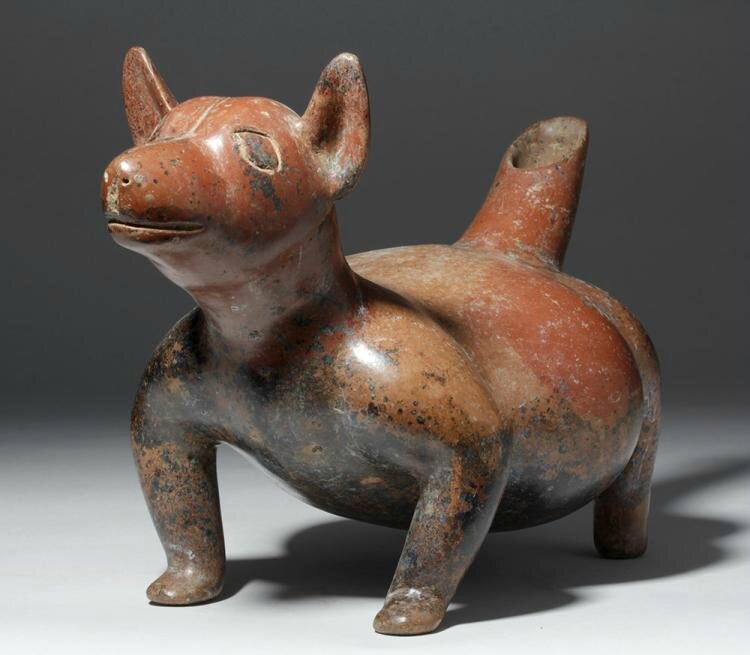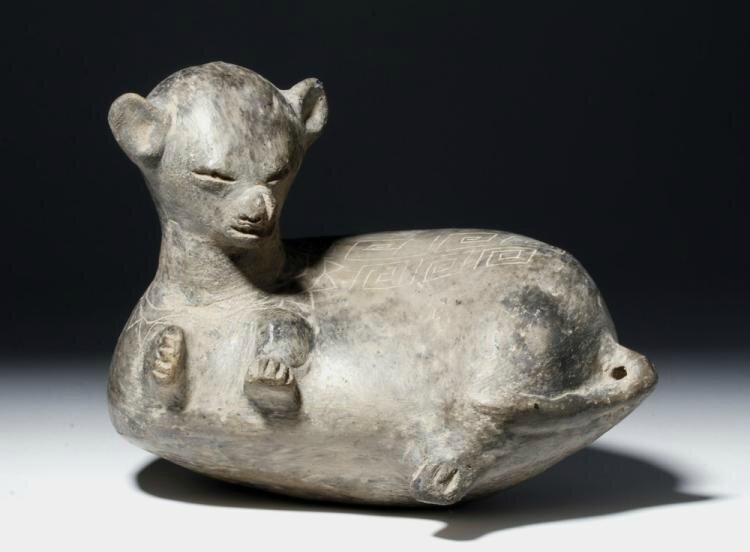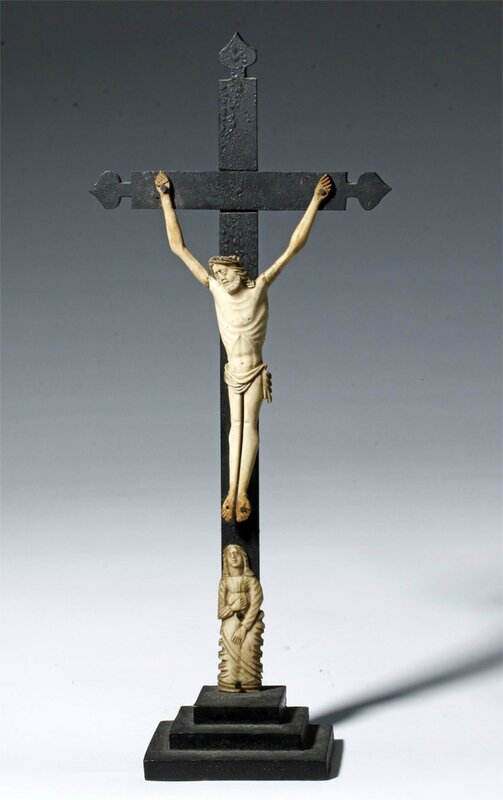Artemis Gallery to host Dec. 1 specialty auction focused on art of the ancient Americas

Lot 80: Inca Bi-Chrome Jar in Form of Parrot, Pre-Columbian, Central Peru, Inca, ca. 1200 to 1500 CE. Estimate: $800 - $1,200. Image courtesy Artemis Gallery.
BOULDER, COLO.- Artemis Gallery is known for its beautifully presented auctions of ancient and ethnographic art from the world’s great civilizations, but their December 1st sale through LiveAuctioneers is taking an intentionally more-focused approach. The sale will showcase the legacy of Pre-Columbian and tribal cultures of the Americas.
“This year we’ve seen a dramatic increase in the number of new collectors entering the Pre-Columbian market,” said Teresa Dodge, executive director of Artemis Gallery. “We decided to create a specialty sale featuring the art and relics of Pre-Columbian Central and South America that included all price points. That way the auction will be accessible to every collector, whether they’re looking for connoisseur’s pieces, moderately valued artifacts or just dipping their toe into the water for the first time.” All 327 auction items are guaranteed to be authentic, as described, and legal to acquire according to federal guidelines. A certificate of authenticity will accompany each purchase.
Teresa and her husband Bob, both experts in antiquities and ancient art, also felt the auction’s exquisite hand-made jewelry and intriguing ethnographic objects would make fantastic holiday gifts, so they designed the catalog with categories to appeal to the shopper seeking something different and unique. Some of the categories are: Jade, Figural Pottery, Wearable Ancient Jewelry, For Animal Lovers, and Just Cool. “Everyone has a person on their holiday shopping list who either has everything or is very hard to please. But any woman would be thrilled with an ancient gold or bead necklace, and any executive would love a conversation piece for their desk or etagere like an Inca terracotta jar in the form of a parrot.”
The auction opens with stunning jade pieces. Lot 3A, a museum-quality Olmec maskette or face panel, was carved from blue-green jadeite stone sometime between 1000 BCE and 400BCE. The maskette, whose graceful facial contours and distinctive features are signature traits of Olmec artisans, is similar to an example held in the Metropolitan Museum of Art. Estimate: $10,000-$15,000. Another Olmec piece, Lot 3C is a circa-700 to 500 BCE jadeite cup engraved with glyphs. The Olmecs were the first known major culture in Mesoamerica and were known for their remarkable jade carvings. The cup is expected to make $9,000-$14,000. Lot 38B, a Costa Rican dark green carved jade avian-form pendant, circa 1-500 CE, was formerly in the collection of Dr. Peter Arnovick. It is estimated at $1,000-$1,500.

Lot 3A. Museum-Quality Olmec Jade Maskette, Pre-Columbian, Southern Mexico to Guatemala, Olmec, ca. 1000 to 400 BCE. Estimate: $10,000 - $15,000. Image courtesy Artemis Gallery.
An exquisite maskette or face panel carved from a beautiful blue-green jadeite stone by an artisan of the Olmec culture, the oldest major civilization in Mexico. The piece is expertly worked with graceful, subtle contours and displays signature Olmec traits including a jowly face, elegant straight nose, downturned jaguar mouth, square jaw, rounded chin, puffy eyelids, and slanted eyes. The blending of both lifelike relatively naturalistic and contrasting abstract representation in this piece is simply mesmerizing. The head is pear-shaped, a sign of high status most likely due to an artificial cranial deformation, as the Olmec traditionally wore tight-fitting helmets. Perforations were made through the ears to suspend ornaments that would have further embellished the personage. To the Olmecs, masks and maskettes like this example carried many meanings, not all of which are obvious to us today; however, scholars surmise that the color green was associated with vibrant growth, renewal, and given the cyclical conception of life and death, rejuvenation after death. In addition, notice that the fleshy, bilaterally symmetrical lips are slightly open so as to reveal the toothless gums of a youthful person, and there is a raised cleft each side of the lower lip. According to scholars, this was the Olmec symbol for corn or maize, which was a crop of such sublime significance to ancient Mexico that it took on religious import from a very early date. A remarkable example, impressive for the artisan's adept carving technique, an indisputable penchant for refined artistry, the inherent beauty of this stone, and the meaningful iconography of the form. Bilaterally perforated at the forehead for suspension or attachment. Clearly of museum-quality. Size: 1.5" deep x 2.25" W x 2.625" H (3.8 cm x 5.7 cm x 6.7 cm)
Similar examples may be found in the most esteemed museum collections of the world. Follow this link for a comparable piece at the Metropolitan Museum of Art.

Mask, Olmec, 10th–6th century B.C., Mexico, Mesoamerica. Jadeite. H. 6 3/4 x W. 6 5/16 in. (17.1 x 16.5 cm). Bequest of Alice K. Bache, 1977. Inv. N+1977.187.33. © 2000–2016 The Metropolitan Museum of Art

Lot 3C. Olmec Jadeite Cup - Engraved with Glyphs. Pre-Columbian, Mesoamerica, Olmec, ca. 700 to 500 BCE. Estimate: $9,000 - $14,000. Image courtesy Artemis Gallery.
Jade is a swirling milky white and turquoise color, translucent enough over approximately a third of its surface that light clearly shines through it. The exterior has two small holes drilled opposite each other at the rim; the exterior of the body is decorated with finely-incised glyph-like designs. The Olmecs, the first major culture known from Mesoamerica, created amazing jade carvings, many of them incised like this one. Jade seems to have been associated with water, vegetation, and young corn, the staple food of Olmec life. Based on burial practices, particularly the objects from important burials at La Venta in the present day Mexican state of Tabasco, we believe that jade was reserved for high nobility, royalty, and the gods. Size: 2.7" W x 2.9" H (6.9 cm x 7.4 cm)
The incised glyphs on this carving are probably epi-Olmec or proto-Mayan. Epi-Olmec, like Mayan, consists of glyphs, often written in lines or columns. Although not all of it has been deciphered, what we know of this language is that it describes religious notions and, to a lesser extent, socio-political matters. It is not clear if glyphs are both pictographic and ideographic, or what role phonograms might have played, and this remains a hotly studied component of Mesoamerican archaeology. With all these questions, can we say anything about this cup? Barring some exceptional circumstances, it was owned by a wealthy person, and buried with them; its glyphs probably speak to the status of the individual or offer a prayer.
Provenance: Ex - private LA County collection acquired before 1990.
An impressive array of figural pottery awaits bidders. Lot 37A is a circa-500 BCE to 500 CE Jamacoaque (Ecuador) polychrome jar fashioned as a jaguar head. This large and important head exhibits great style and even has a removable pottery nose ornament. With provenance from a Hollywood, Calif., collection and previously from Ron Messick Fine Arts of Santa Fe, N.M., it is on target to reach $4,000-$6,000 at auction. From the same culture and timeframe, a terracotta figure of a woman wearing a large headdress and adorned with ear and nose ornaments, a necklace and bracelets, is estimated at $3,000-$5,000. Its provenance includes the Terra Collection of Houston, Texas.

Lot 37A: Jamacoaque Polychrome Jar of Jaguar Head, ex-Messick, Pre-Columbian, Ecuador, Jamacoaque (Jama Coaque), ca. 500 BCE to 500 CE. Estimate: $4,000 - $6,000. Image courtesy Artemis Gallery.
Large & important terracotta head of a jaguar, one of the most beautiful stylized jaguar heads weve seen of this culture! Remains of post fired yellow, red and cream colored paint. Note: the ornamented nose ornament is inserted in the nose and can be moved. Size: 8.5" W x 7.5" H (21.6 cm x 19 cm)
Provenance: Ex-private Hollywood, CA Collection, acquired from Ron Messick Fine Arts, Santa Fe, NM.

Lot 37C: Jamacoaque Polychrome Female Figure on Her Belly. Pre-Columbian, Ecuador, Jamacoaque (Jama Coaque), ca. 500 BCE to 500 CE. Estimate: $3,000 - $5,000. Image courtesy Artemis Gallery.
Female terracotta figure laying belly down on the ground. Her erect torso upright, arms held in chest height. She wears a large head dress, ear and nose ornaments, and is adorned with a necklace and bracelets. Size: 6.5" W x 7.5" H (16.5 cm x 19 cm)
Provenance: Ex-Terra Collection, Houston, TX acquired before 1975.
Many Pre-Columbian cultures chose dogs as the subjects of their ceramic wares. Several excellent examples are available in the Dec. 1 auction, including Lot 21, a circa-300 BCE to 300 CE Colima (Western Mexico) “Chichi” or “Escuintla” hairless canine vessel. A representation of the ancestor of the Chihuahua or Mexican hairless breed, this stout, 16-inch-long pottery pup is entered with an auction estimate of $5,000-$7,500. Lot 49C is a hollow brownware pottery dog effigy from the Guangala culture of Ecuador. Made circa 500 CE, the dog has perky round ears and expressive facial features. Ex Shillo Adir collection, New York, N.Y., it comes to auction with an $800-$1,200 estimate.

Lot 21: Large & Very Fine Colima Pottery Dog. Pre-Columbian, West Mexico, Colima, ca. 300 BCE to 300 CE. Estimate: $5,000 - $7,500. Image courtesy Artemis Gallery.
A very fat example of the famous Colima dog, standing with his legs spread wide, ears perked, and tail pointed upwards, forming a spout. Scholars know of at least two types of Colima dogs, one to be fattened up and ritually sacrificed or eaten and one to serve as a watchdog and healer of the ill. This plump hairless canine known as a Chichi or Escuintla is thought to be related to the Chihuahua or Mexican Hairless also known as the Xoloitzcuintle. The Xolo dog was named for the deity Xolotl, the God of the Underworld, and believed to guide the deceased as they journeyed to the afterlife. Colima vessels such as this one were buried in shaft tombs to protect the deceased and provide sustenance for eternity. This example is practically life-sized! Size: 16.1" L x 8.8" W x 10" H (40.9 cm x 22.4 cm x 25.4 cm)
Provenance: Ex-Mitchell collection

Lot 49C: Guangala Brownware Dog Effigy. Pre-Columbian, Ecuador, Guangala culture, ca. 500 AD. Estimate: $800 - $1,200. Image courtesy Artemis Gallery.
This is a reclining pottery dog effigy, hollow and made of brownware. It has a large, rounded body and expressive facial features with incised geometric details and perky round ears. Diminutive feet and tail give the animal a playful appearance. However, this type of effigy probably represents a dog that has been fattened up to be sacrificed and eaten! Size: 8.5" L x 5.25" W x 5.75" H (21.6 cm x 13.3 cm x 14.6 cm)
Provenance: Ex-Park Avenue Collector Shillo Adir, Acquired 1970s.
There are many wonderfully wearable selections in Artemis Gallery’s jewelry chest. Lot 7 has the unmistakable look of a luxury jeweler’s top-of-the-line sterling silver design, and for good reason. The necklace is styled as flowing rivulets that merge to form a cascade of intertwined silver terminating in six ancient Chavin (Peru, 900-200 BCE) beads of greenstone and crystal/quartz. The one-of-a-kind necklace was created by the renowned Muzeion Gallery, Dallas, and is estimated at $2,000-$3,000.


Lot 7: Necklace with Ancient Chavin Stone Beads. Pre-Columbian, Peru, Chavin, 900 to 200 BCE. Estimate: $2,000 - $3,000. Image courtesy Artemis Gallery.
An interestingly-shaped sterling silver necklace with cascading curved silver beads beautifully accented with six ancient Chavin beads at center - three round, and greenstone, and three cylindrical and crystal / quartz. Size: 17.5" L (44.4 cm)
Provenance: Wearable, one-of-a-kind custom-designed ancient art jewelry from Muzeion Gallery, Dallas, TX
The ethnographic and tribal categories are brimming with quality items. Lot 92C, a circa-19th-century CE carved-wood crucifix with a bone figure of Jesus on the cross and the Virgin Mary at his feet, is of South American origin. The 16-inch artwork is crafted in the Romanesque style with a thin, elongated torso and limbs. Estimate: $1,800-$2,200.

Lot 92C: Wood Crucifix with a bone figure of Jesus on the cross and the Virgin Mary at his feet. South America, Bolivia or Peru, ca. 19th century CE. Estimate: $1,800 - $2,200. Image courtesy Artemis Gallery.
Wonderful carved wooden crucifix with bone figure of Jesus on the cross, with The Virgin Mary at his feet. Carved in Romanesque style with thin abstracted torso, stylized drapery and elongated limbs. Size: 16" H (40.6 cm)
Provenance: Ex - Rev. Richard Kellaway collection, Fairhaven, MA.
A fascinating entry is Lot 148A, a metal-bladed adze (wood-cutting tool) from the Trobriand Islands. Traditionally, such implements were highly prized by the Trobriand people, horticulturalists who still live on an atoll of coral reefs off the coast of Papua New Guinea and use yams as currency. The adze is estimated at $1,800-$2,500

Lot 148A: Wood Adze with Metal Blade, South Pacific, Solomon Sea (Trobriand Islands), 19th century CE. Estimate: $1,800 - $2,500. Image courtesy Artemis Gallery.
An excellent wood adze with a flat metal blade bound to its end. The handle is shaped like the head of a long-necked bird, with carvings as a crest at the top and at the bottom. The Trobriand Islands dangle off the southeastern tip of Papua New Guinea, a small archipelago of coral atolls populated by subsistence horticulturalists for whom yams are currency. The people of the Trobriand Islands and other nearby archipelagos have formed a trading network in which items like this adze are highly valued. These large, fine adzes, and specifically their blades, circulate around the archipelagos continually, given as gifts. Size: 15.25" L x 7" W (38.7 cm x 17.8 cm)
Provenance: Ex - B. Mussin collection, San Diego, CA acquired via descent.
Bidders may participate in Artemis Gallery’s Thursday, Dec. 1, 2016 auction live online, by phone (please reserve phone line in advance) or by leaving an absentee bid that will be lodged confidentially and competitively on their behalf. Start time is 10 a.m. Eastern. Bid absentee or live via the Internet through LiveAuctioneers.

/https%3A%2F%2Fprofilepics.canalblog.com%2Fprofilepics%2F1%2F0%2F100183.jpg)
/https%3A%2F%2Fstorage.canalblog.com%2F03%2F02%2F119589%2F96711876_o.jpg)
/https%3A%2F%2Fstorage.canalblog.com%2F11%2F31%2F119589%2F94773502_o.jpg)
/https%3A%2F%2Fstorage.canalblog.com%2F20%2F83%2F119589%2F94772815_o.jpg)
/https%3A%2F%2Fstorage.canalblog.com%2F26%2F72%2F119589%2F75604929_o.jpg)
/https%3A%2F%2Fstorage.canalblog.com%2F59%2F60%2F119589%2F26458628_o.jpg)


/http%3A%2F%2Fstorage.canalblog.com%2F00%2F00%2F119589%2F129758935_o.jpg)
/http%3A%2F%2Fstorage.canalblog.com%2F29%2F28%2F119589%2F129637299_o.jpg)
/http%3A%2F%2Fstorage.canalblog.com%2F88%2F37%2F119589%2F129631480_o.jpg)
/http%3A%2F%2Fstorage.canalblog.com%2F77%2F79%2F119589%2F129631259_o.jpg)